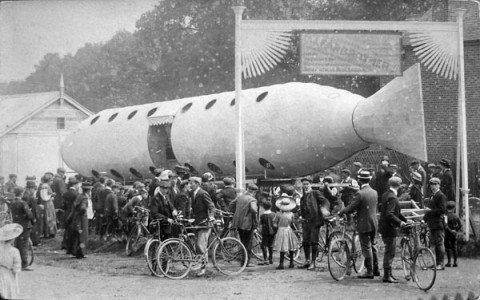
Nobody commented on the Wokingham Whale. Above is a photograph of this unlikely beast, dating from 1910 or so. All I know about it is from the Globe and this site, which has several other photos as well.
The Whale was not an airship, although that word was used to describe it. Despite the shape, that’s not a gasbag but a fuselage. A 80hp engine was to drive a 1200rpm ‘rotoscope’ (presumably meaning a propeller, which Patrick Alexander apparently designed). The ‘portholes’ are actually to slide poles through, to support canvas wings. The fuselage was 66 feet long, and was designed to extend ‘telescopically’ to 140 feet in length. It would be fitted for long-distance overseas flights, with seats, electric lights, hammocks and toilets.
It’s clearly an example of reach exceeding grasp: there’s no way something that big and solid could be made to fly with the technologies of 1910. I don’t understand what the point of a telescoping fuselage would be, either. But we do travel overseas today in long enclosed tubes with the amenities mentioned (minus the hammocks!), so the Whale’s inventor, A. M. Farbrother (owner of a Wokingham joinery), did have some insight into the future of aviation.
Unfortunately, Farbrother sold his own cottage to fund his flying machine. He and the locals who also contributed must have been bitterly disappointed when money ran out and the fuselage broken up.
Supposedly Flight had some contemporary articles about the Whale but a quick search didn’t turn up anything.
![]() This work is licensed under a Creative Commons Attribution-NonCommercial-NoDerivatives 4.0 International License.
Permissions beyond the scope of this license may be available at http://airminded.org/copyright/.
This work is licensed under a Creative Commons Attribution-NonCommercial-NoDerivatives 4.0 International License.
Permissions beyond the scope of this license may be available at http://airminded.org/copyright/.


The telescoping fuselage strikes me as a fairly typical engineer’s innovation: flexibility, adaptability. He may not have determined the necessary wing size yet: it could be that a longer fuselage would allow a larger wing, if necessary.
I didn’t comment because I was, and remain, flabbergasted. What we need here is a time machine. Not to go back to the era, but to collect the great historians of mentalite so that they can contrive some scientific index of the “What were we thinking”-ness of past eras and see if the Edwardian age really did hit a peak score.
Jonathan:
You could be right, but it doesn’t seem prudent to build a full-size airframe without having a good idea of how large a wing you’ll need! No wonder he ran out of money.
Erik:
Yes, I think there’s some mentalite at work here! Looking at the link again, it seems that the ‘rotoscope’ might have been more of a helicopter rotor — it’s said to provide lift (though that may be a misunderstanding of somebody along the way). It occurred to me that perhaps Farbrother was inspired by proto-sf more than early aviation, and was trying to build an aeronef of some sort? With a long ‘hull’, some spreading wings and a rotor on a long pole, it seems reminiscent of something out of Verne or Robida or something like that.
sorry..still speechless
I’m trying to work out how the fuselage was loaded on to that small cart!